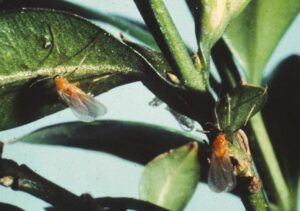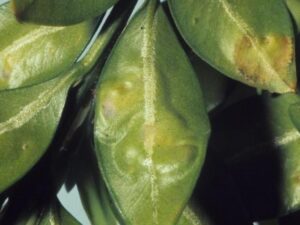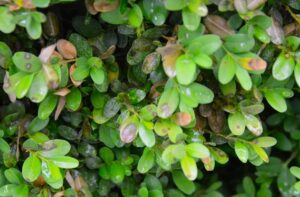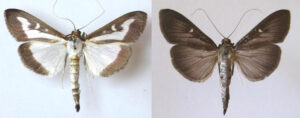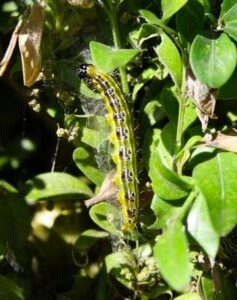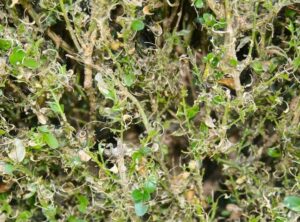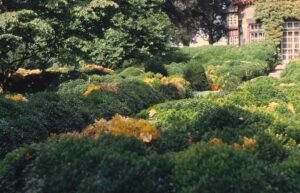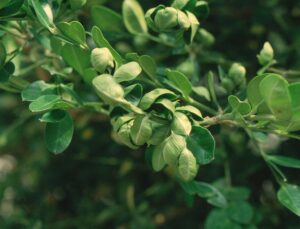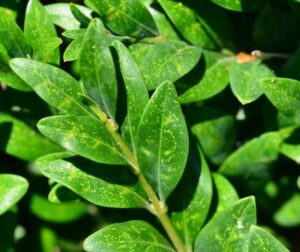Blight, Leafminers, and Moths: The Plight of Boxwoods
Boxwoods (Buxus spp.) were introduced into the United States during colonial times, and still today they are one of the most popular evergreen shrubs used in landscapes. They are frequently selected for hedges and topiaries because they are easily trimmed into geometric shapes. They were also easy to maintain and had very few, if any, insect or herbivore problems at that time.
This changed in the 1970s when “boxwood decline” began sweeping across landscapes. This catch-all term did not have a singular cause, but was a combination of factors. Conditions such as improper drainage, over-pruning, over-mulching, fungal pathogens, nematodes, and winter injury are all associated with decline. The issue led to the breeding of several new cultivars which were resistant to the disease complex, but unfortunately, they were extremely susceptible to boxwood leafminer, (Monarthropalpus flavus).
Boxwood leafminer (Fig. 1) is a small yellow fly native to Europe. It was likely introduced with imported boxwood plants, and is now distributed across the United States. The adults lay their eggs on boxwood leaves in late spring (April-May). Eggs hatch in 2-3 weeks, and the larvae feed inside the leaf, causing the leaf to form a blister (Fig. 2). Larvae develop throughout the summer, and then overwinter as pupae inside their mines. Adults emerge in spring to begin the cycle again.
- Fig. 1: Boxwood leafminer adults. Image credit: Jim Baker, North Carolina State University
- “Fig. 2: Boxwood leafminer blisters. Image credit: Jim Baker, North Carolina State University”
Boxwood leafminer quickly became the most severe pest of boxwoods, and this led to more cultivar development in the search for resistance. d’Eustachio and Raupp (2001) identified cultivars resistant to leafminer, but still today boxwood leafminer is the most damaging insect pest of boxwoods.
Leafminer wouldn’t be the last problem to plague boxwoods. In 2011, boxwood blight was introduced to the United States in North Carolina and Connecticut. Boxwood blight is a fungal disease caused by Calonectria pseudonaviculata. This disease causes leaf spots and stem cankers (Fig. 3), which spread throughout the entire aboveground portions of the plant, ultimately resulting in plant death if left unmanaged. It has been detected in at least 30 states (Castroagudin et al. 2020).
- Fig. 3: Boxwood blight symptoms. Image credit: David L. Clement, University of Maryland
In 2022, Yoder et al. evaluated 146 cultivars against leafminer, and 75 cultivars against boxwood blight. They identified five cultivars with resistance to both pests: ‘Peergold’, ‘Cole’s Dwarf’, ‘SB 108’, ‘SB 300’, and ‘Wee Willie’. These options provide a solution to two of the most severe boxwood pests, which is great news for nursery suppliers and landscapers who sell boxwoods. Unfortunately, there is a new invasive insect in the US which is the worst pest of boxwoods yet.
Box tree moth (Cydalima perspectalis) is the next major threat to boxwoods. Between August 2020 and April 2021, infested boxwoods were shipped from a Canadian nursery to distributers in Connecticut, Massachusetts, Michigan, New York, Ohio, Tennessee, and South Carolina. It was confirmed in New York and Michigan in 2021, and in Massachusetts and Ohio in 2023. Several counties in Ohio and New York are now under quarantine to prevent the movement of this pest.
Box tree moth adults have two color variations: brown or white with a brown border (Fig. 4), although the white form is much more common. Both forms have a distinct white comma-shaped marking in the center of the forewing. However, it’s rare to find an adult because they typically fly at night. The caterpillars, which cause the damage to the plant, are easier to spot. They are lime green with black stripes, and they have a black head with a white “Y” in the middle (Fig. 5). The most tell-tale sign of a box tree moth infestation is the chewing damage to the foliage due to larval feeding (Fig. 6). In severe cases, this insect can completely defoliate a boxwood.
- Fig. 4. Box tree moth adults. Image credit: Szabolcs Sáfián, University of West Hungary
- Fig. 5: Box tree moth larva. Image credit: Ferenc Lakatos, University of Sopron
- Fig. 6: Box tree moth damage. Image credit: Ferenc Lakatos, University of Sopron
In addition to the severe issues outlined above, there are numerous minor pests and diseases of boxwoods. Volutella blight is a fungal disease caused by Pseudonectria foliicola and P. buxi. They are weak pathogens that attack stressed plants, and can cause limb loss which decreases the plant quality (Fig. 7). Boxwood psyllids (Cacopsylla busi) feed on terminal leaves, resulting in leaf cupping which reduces aesthetic appeal (Fig. 8). Boxwood mites (Eurytetranychus buxi) are spider mites whose feeding causes yellow pin-prick spots on the leaves (Fig. 9).
- Fig. 7: Volutella blight symptoms. Image credit: Penn State Department of Plant Pathology & Environmental Microbiology Archives
- Fig. 8: Boxwood psyllid leaf cupping damage. Image credit: Penn State Department of Plant Pathology & Environmental Microbiology Archives
- Fig. 9. Boxwood mite leaf stippling damage. Image credit: David L. Clement, University of Maryland
Should you still use boxwoods in the landscape? They have numerous good qualities, including deer resistance, environmental hardiness, and evergreen foliage. With new resistant varieties available for blight and leafminer, and several chemical control options for box tree moth, the pest and disease problems are manageable. In addition, resistance research for box tree moth is in progress. The decision ultimately rests with both the landscape professional and homeowner, yet they should consider the potential expenses associated with managing pest and disease issues in making their choice. Below is a list of alternatives to boxwoods that are native to the USA that may serve as a better option depending on the needs of the landscape.
Boxwood alternatives:
Evergreens:
Inkberry Holly (Ilex glabra)
Eastern arborvitae (Thuja occidentalis)
American yew (Taxus canadensis)
Eastern red cedar (Juniperus virginiana)
Deciduous woody plants:
Winterberry (Ilex verticillata)
Red twig dogwood (Cornus sericea)
Lowbush blueberry (Vaccinium angustifolium)
Blackhaw Viburnum (Viburnum prunifolium)
Citations:
- Castroagudin et al. (2020) Boxwood Blight Disease: A Diagnostic Guide. Plant Health Progress. 21: 291-300.
- d’Eustachio and Raupp (2001) Resistance of Boxwood Varieties to the Boxwood Leafminer, Monarthropalpus flavus (Schrank). Journal of Environmental Horticulture. 19(3): 153–157.
- Yoder et al. (2022) Field Performance of Buxus Cultivars and Selections Against Boxwood Leafminer and Boxwood Blight. Journal of Environmental Horticulture. 40(4): 129–142.
